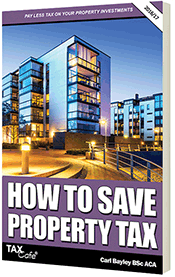Mortgage Interest Tax Relief Guide
By Nick Braun PhD
It’s essential to squeeze every drop of mortgage interest tax relief out of your borrowings. Here’s my short survival guide:
How to Save Property Tax
Pay off your Mortgage
If you have any savings use them to pay off the mortgage on your home. If you put £100 in a savings account and earn £5 interest you’ll be left with just £3 after the taxman has taken his slice. But if your mortgage interest rate is 6%, you will pay £6 per year on every £100 of debt.
In other words you pay twice as much interest as you earn on identical sums of money.
If your mortgage interest rate increases to 7%, any extra house repayments you make will be equivalent to earning 12% from a savings account. There isn’t an account alive that offers such a high guaranteed return!
Buy-to-let Mortgage Interest Tax Relief
It’s better to pay off the mortgage on your home first because that interest is not tax deductible. Paying off a buy-to-let mortgage isn’t quite so attractive because the interest qualifies for tax relief.
However, reducing your buy to let mortgages can be the best strategy if the interest rates are very high or having a lower loan to value ratio secures you a better deal when you refinance.
The fact interest is tax deductible may not matter much if you’re making rental losses anyway.
Is my Interest Tax Deductible?
Property investors are often unsure whether their interest is deductible. This depends on how the money is used. Use it to buy investment property and the interest is tax deductible. Use it for personal reasons and the interest is not deductible.
There is an exception to this rule: you can generally remortgage an investment property up to its original purchase price and the interest will be tax deductible, whatever you use the money for. For example, let’s say you bought a buy-to-let for £100,000 and the current mortgage is £60,000. You can borrow up to another £40,000 (if the bank will let you!) and all the interest will be tax deductible, no matter how you use it.
Using a Property Company to Save Tax
With rental income insufficient to pay borrowing costs, using a company is one way of getting the taxman to completely fund your rental losses.
For example, let’s say Gordon and Alistair each borrow £1 million and pay £80,000 interest. Gordon invests personally and earns a rental profit of £70,000 before interest. After deducting interest costs he’s left with a rental loss of £10,000 which he can only carry forward.
Alistair lends his borrowed funds to his property company and its properties also yield a rental profit of £70,000. Corporation tax at 22% comes to £15,400.
Meanwhile, Alistair personally claims interest relief for £80,000. This will produce a tax repayment of £32,000 (£80,000 x 40%). Alistair and his company receive an overall tax refund of £16,600 (£32,000 - £15,400).
Remarkably, this net refund actually exceeds the overall deficit of £10,000 on the company’s property portfolio. In other words, Alistair’s interest relief has turned an effective loss before tax of £10,000 into an effective profit after tax of £6,600 (£16,600 - £10,000).
The Government is therefore effectively funding Alistair’s property portfolio and adding a little extra too!






